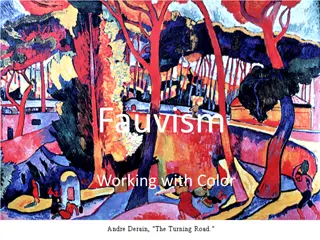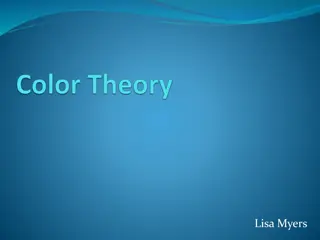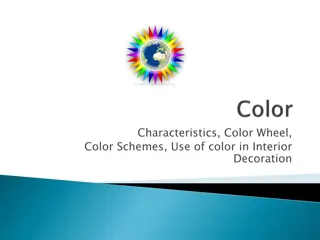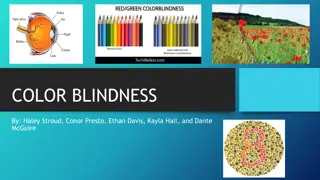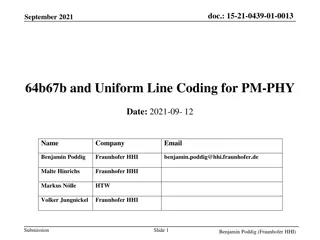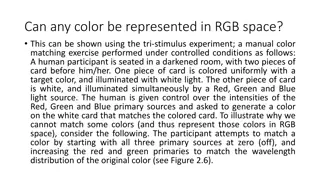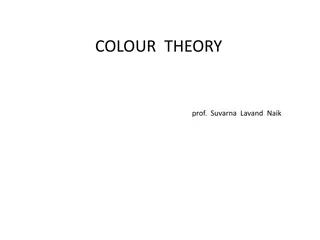
Color-Coding Method: Finding Paths and Subgraphs in Graphs
Explore the Color-Coding method by Alon, Yuster, Zwick, and Patel for finding simple paths, cycles, and subgraphs of specified lengths in graphs efficiently. Learn about random coloring, colorful paths, lemma, and examples in this algorithmic technique.
Uploaded on | 3 Views
Download Presentation

Please find below an Image/Link to download the presentation.
The content on the website is provided AS IS for your information and personal use only. It may not be sold, licensed, or shared on other websites without obtaining consent from the author. If you encounter any issues during the download, it is possible that the publisher has removed the file from their server.
You are allowed to download the files provided on this website for personal or commercial use, subject to the condition that they are used lawfully. All files are the property of their respective owners.
The content on the website is provided AS IS for your information and personal use only. It may not be sold, licensed, or shared on other websites without obtaining consent from the author.
E N D
Presentation Transcript
Color-Coding Method Noga Alon | Raphael Yuster | Uri Zwick Darshak Patel COMP 5112/COMP4900G: Algorithms for Data Science 27-Nov-2024
Introduction Purpose: Introduce a technique, "Color-Coding" for finding simple paths and cycles and subgraph for specified length in polynomial time. Key Methods to discussed today: Random Coloring A novel randomized method, for finding simple paths and cycles of a specified length k, and other small subgraphs, within a given graph G = (V, E).
Random Coloring Let G = (V, E) be a graph (directed or undirected). Choose a random coloring of the vertices of G with k colors. A colorful path is defined as a path where all vertices have distinct colors. This looks very simple. Each simple path of length k-1, has a chance to become colorful. ?! ??> ? ? How much time is needed to find a colorful path of length k-1 in G, if one exists, or all pairs of vertices connected by colorful paths of length k-1 in G?
Lemma Graph G = (V, E) , Here V=5 2 3 1 4 5
Graph G = (V, E) , Here V=5, E=5 2 3 1 4 5
Choose a random coloring of the vertices of G with k colors, c : V -> {1,2,..,k}; k=5 and a vertex s belongs to V. 2 Finds a colorful path of length k -1 that starts at s, if one exists. 3 s 1 A path in G is said to be colorful if each vertex is colored by a distinct color. 4 5
To find a colorful path of length k -1 in G that starts somewhere, we just add a new vertex s0 to V. We just add a new vertex s0 to V. 2 Color it with a new color 0 and connect it with edges to all the vertices of V. 3 We now look for a colorful path of length k that starts at s0. 1 s0 s 4 5
Lemma Proof Example with V = 5 and E = 5 Let us now apply the algorithm to a specific graph with 5 vertices and 5 edges. Consider the graph G = (V, E), where: V = {v1, v2, v3, v4, v5}, E = {(v1, v2), (v2, v3), (v3, v4), (v4, v5), (v5, v1)}.
Proof (cont.) The graph is a cycle of 5 vertices, and we assign the following coloring: c(v1) = 1, c(v2) = 2, c(v3) = 3, c(v4) = 4, c(v5) = 5. We are looking for a colorful path of length 4, i.e., a path that uses all 5 colors. We can apply the dynamic programming approach described above.
Proof (cont.) Step-by-Step Application of the Algorithm 1. **Initialization**: Initially, we know that the path starting at v1 uses only the color 1: C(v1, 0) = {1}, C(v2, 0) = , C(v3, 0) = , C(v4, 0) = , C(v5, 0) = . 1
Proof (cont.) 2. **Paths of Length 1**: From v1, We can extend the path to v2, adding color 2: C(v1, 1) = {1}, C(v2, 1) = {1, 2}. For other vertices: C(v3, 1) = , C(v4, 1) = , C(v5, 1) = . 2 1
Proof (cont.) 3. **Paths of Length 2**: From v2, we extend the path to v3, adding color3: C(v3, 2) = {1, 2, 3}. For other vertices: C(v4, 2) = , C(v5, 2) = . 2 3 1
Proof (cont.) 4. **Paths of Length 3**: From v3, we extend the path to v4, adding color4: C(v4, 3) = {1, 2, 3, 4}. For other vertices: C(v5, 3) = . 2 3 1 4
Proof (cont.) 2 5. **Paths of Length 4**: Finally, from v4, we extend the path to v5, adding color 5: C(v5, 4) = {1, 2, 3, 4, 5}. We have found a colorful path of length 4, which uses all the colors 1, 2, 3, 4, 5. The path is : v1 v2 v3 v4 v5. 3 1 s0 s 4 5
Proof (cont.) The graph G contains a colorful path of length k 1 with respect to the coloring c if and only if the final collection corresponding to paths of length k 1 for at least one vertex is non-empty. The number of operations performed by the algorithm is at most
Class Notes: 13.4.7 Color Coding Consider the longest path problem in an undirected graph. Input: An undirected simple graph G = (V, E) on n vertices and a positive integer k n. Output: Does there exists a simple path consisting of at least k vertices in G.
Color coding for finding long paths Step 1: Repeat Steps 2 and 3 for ?(??ln?) times. Step 2: Color the vertices of G uniformly at random independently from {1,...,?}. Step 3: Check if there exists a path ? = (?1,..,??) such that each vertex ?? is colored ?. If such a path exists, output TRUE and terminate. Step 4: Output G contains no simple path of length k.
Lemma 13.4.29 If there exists a simple path ? = (??,...,??) in G, the probability that for all ? {?,...,?}, the vertex ?? is assigned the color ? is ? ??. Proof: Since there are k colors, the probability of assigning a specific color ? to vertex ?? is1 The coloring of each vertex is independent of the others. Therefore, the probability that ?1 is assigned color 1, ?2 is assigned color 2, and so on, up to ?? being assigned color k, is given by the product of individual probabilities: Pr ??? ?? ??? ???????? ??????? ?????? = ?. 1 ? . 1 ? . 1 ? 1 1 ?= (1 ?)? = 1 ? ? = ?=1 ??
Refrences Noga Alon, Raphael Yuster, and Uri Zwick. Color-coding. J. ACM, 42(4):844 856, 1995 Maheshwari, A. (n.d.). Design and analysis of algorithms: Lecture notes. Carleton University. Retrieved from https://people.scs.carleton.ca/~maheshwa/Notes/DAA/notes.pdf






